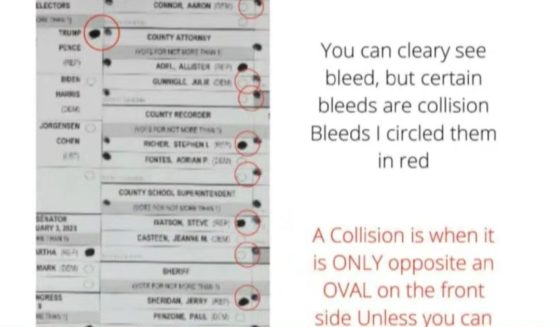AZ Audit Revelation: Wrong Paper Was Used for Ballots, Could Confirm 'SharpieGate' According to AZ Sen President
UPDATE, July 23, 2021: On July 15, Maricopa County officials issued the following tweet claiming that “SharpieGate has been debunked already” without actually addressing the fact of the images presented during the Senate hearing that showed ballots with bleed-through marks on them:
This accuracy is verified through logic and accuracy tests, hand counts performed by the political parties, and post-election audits performed by EAC certified voting testing laboratories. #SharpieGate has been debunked already.https://t.co/ltmk5lr4N2
— Maricopa County (@maricopacounty) July 16, 2021
It should also be noted that Maricopa County elections officials initially resisted the election audit, have demonstrably failed in many ways to cooperate with the audit process, have been accused by elected state officials of stonewalling the audit efforts still today, and would be considered responsible for any improprieties uncovered by the audit. While some of the county’s arguments may be factual, county officials are defending their own performance and cannot therefore be considered impartial or unbiased sources of information in this matter.
Asked about “SharpieGate” on Thursday, Republican Arizona Senate President Karen Fann told Western Journal Editor-in-Chief George Upper, “There is mistruth that is being put out there, or misstatements. So, for example, we can go back to an actual public document that [Maricopa County officials] had on their website and they put out there and said, ‘We only use four types of paper for our ballots and those ballots are, it’s a special kind of paper that has, I believe, it’s a titanium film on it, if you will, which actually prevent people from, from the ballots, from seeping through on the other side. Well, we know for a fact from the hearing last Thursday that there is a lot of ballots out there that they marked through, and images of them. So clearly, that was misinformation when they said we only use four types of paper. We actually now have affidavits from people who actually worked at the polls, and because of the on-demand ballots that they print, that they were not using any special paper. As a matter of fact, if they ran out of paper, somebody was sent down to the nearest office supply store to pick up more paper. So that in itself is, obviously, that’s not secure paper. Obviously, you’re going to have bleed-throughs.
“They originally said, well, even if there was bleed-through, it’s designed — the ballot’s designed — so that there’s no way we could do it [make the ballot unreadable]. But you saw Thursday copies of actual ballots that not only bled through but here was the marking for a candidate and here was the marking for another candidate that apparently bled through from the other side. And it is within this target area of where the machines scan those ballots. Which might explain where there were so many more adjudicated ballots this year than ever.
“I don’t have the statistic in front of me and I can’t even remember when I [read] it, but I do remember back in April there was a statement that was made from Maricopa County that said there was over 11 percent adjudicated ballots [in 2020]. I’m still trying to find that as my backup to that, but clearly that is way more than they’ve ever, ever had. And so, that explains that. But why, so why aren’t they talking to us about it? Why aren’t they saying, ‘Yeah, we do believe there could be these problems here,’ but they’re not.
“Instead, they’ve set up a Twitter account on social media, and working in concert with the liberal media, [they’re] trying to cover any mistakes that maybe they had made, or anything. I don’t understand why they want to fight this out or do this, trying to defend themselves on a Twitter site, rather than just sit down with us and say, “Let’s go through this and see if we can find some explanations for you.'”
Watch the entire interview with Sen. Fann here.
There may now be reason to believe that in November 2020, Sharpies did, in fact, cause significant voter discrepancies on ballots, according to new information that has come out of the Arizona state audit of the 2020 general election.
The CEO of Cyber Ninjas — a software security company — and lead auditor Doug Logan reported that further examination of ballots yielded evidence that appears to support the SharpieGate controversy.
During a broadcasted state Senate hearing regarding the audit’s findings held on Thursday, Logan presented several photographic examples of improperly marked ballots.
The auditor described that anyone viewing the ballot could clearly see how the Sharpie marks filled in are bleeding through to the other side of the paper. This leaves room for the possibility of misreadings as ballots are counted.
“If they’re offset, what it means is when — if it bleeds through — it can potentially cause an overvote,” Logan said.
“It can potentially cause you to vote for someone that you didn’t intend to vote for.”
“Now, specifically, we should not have had problems with bleed-through,” the lead auditor added.

Logan pointed to a specific statement that Maricopa County (the state’s most populous, encompassing the Phoenix metropolitan area) released on the matter in an attempt to address the election concerns raised, claiming that all ballots were cast using VoteSecure paper — which is used to prevent bleed-through.
[firefly_poll]
“Maricopa County uses several different types of printers to ensure voters have the ability to cast a ballot in the way that works for them,” the statement read. “No matter the mode in which a voter casts a ballot, all counted ballots are printed on VoteSecure paper.”
The auditor explained that VoteSecure paper is particularly thick and has a special coating that prevents bleed-through. Therefore, if someone were to make a mistake and use the wrong writing implement on their ballot, their vote would still be successfully counted. However, when this paper is not used, it leaves more room for error.
Despite the county’s claims that special paper was used, Logan and other auditors have reason to believe that not all ballots were printed using VoteSecure paper.
“This is an indication of problems that could cause an overvote situation, or could cause votes to be cast for a different candidate than intended,” Logan said.
Arizona Senate President Karen Fann, who presided over the hearing along with Arizona Senate Judiciary Committee Chairman Warren Petersen, asked Logan to clarify his remarks.
“So, Maricopa County, you’re saying — on their website — said that they only use secure paper which does not allow for bleed-through, correct?”
“Correct. Correct. This is actually a newsletter from them, but yes,” Logan said.
According to the Citizens Clean Elections Commission in Arizona, the use of Sharpies was prohibited in past years for filling out ballots, however, the Maricopa County polling centers actually recommended the writing implement in the Nov. 3, 2020, election, due to “new election equipment” being utilized. Therefore, “Sharpies were distributed for ALL voters on Election Day.”
If the county knew it was not issuing ballots on the correct paper, this raises even more questions about why Sharpies were being handed out at voting centers — questions that remain unanswered.
Fann then pointed out that, if it were true that VoteSecure paper was used, there would be “no way” for bleed-through to have occurred.
Logan agreed, saying, “Based on our discussions with paper experts, they specifically state that that paper is thick enough. It wouldn’t bleed through. And we are seeing a lot of very thin paper stock being utilized, especially on election day.”
The lead auditor went on to say that bleed-through could occur with a regular ballpoint pen, as well — however, the possibility was obviously greater with Sharpies.
Fann also highlighted Maricopa County’s initial claims that, had there been bleed-through, it wouldn’t have affected any of the votes.
She then asked Logan to confirm or deny the SharpieGate rumors — that the use of Sharpies ultimately invalidated votes when ballots were cast.
“We would need more analysis in our final report. We would be able to tell you more, more clearly, whether this impacted things or not. But definitely, if there was an offset, if it was in the right direction, the right way, and there was bleedthrough, it could definitely impact the ballot,” Logan said.
Other reported issues that came up included the printing of the ballots themselves. Logan said that “printer calibration” could also be responsible for incorrectly analyzed ballot markings.
According to Logan, many of the “on-demand” ballots that were printed the day of voting — ballots not printed on VoteSecure paper — were responsible for the offsets.
“Do we know how many ballots on demand there were?’” Fann asked.
“It would be roughly 168,000, which would be election day ballots,” Logan responded.
“We are seeing more than that, where this offset occurred. And so we are trying to drill into what printers and where, and what that’s tied to.”
This audit is far from over.
More information is expected to be released as the state audit continues. Further information concerning the state Senate hearing and the future of the Arizona audit can be found in The Western Journal’s report here.
Watch the full Senate hearing on the Arizona audit here.
This article appeared originally on The Western Journal.











